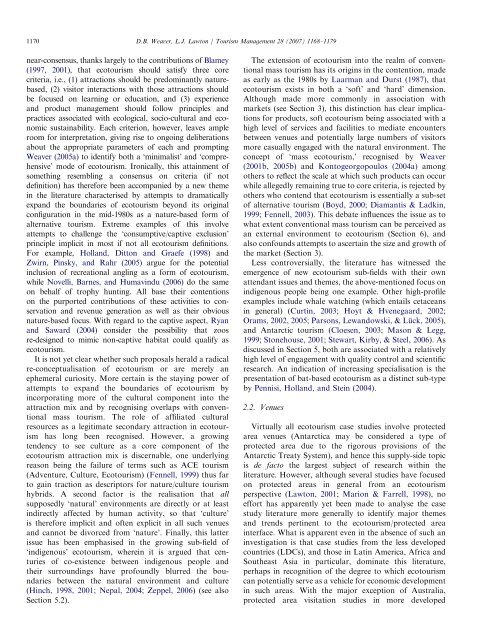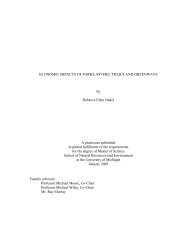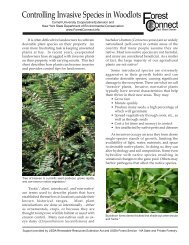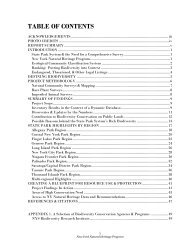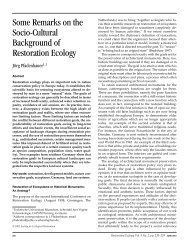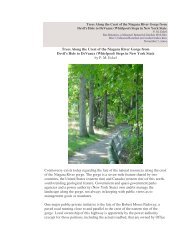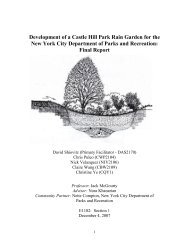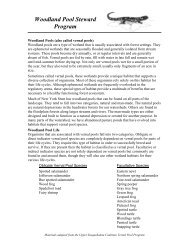Twenty years on: The state of contemporary ecotourism research
Twenty years on: The state of contemporary ecotourism research
Twenty years on: The state of contemporary ecotourism research
- No tags were found...
You also want an ePaper? Increase the reach of your titles
YUMPU automatically turns print PDFs into web optimized ePapers that Google loves.
1170ARTICLE IN PRESSD.B. Weaver, L.J. Lawt<strong>on</strong> / Tourism Management 28 (2007) 1168–1179near-c<strong>on</strong>sensus, thanks largely to the c<strong>on</strong>tributi<strong>on</strong>s <strong>of</strong> Blamey(1997, 2001), that <strong>ecotourism</strong> should satisfy three corecriteria, i.e., (1) attracti<strong>on</strong>s should be predominantly naturebased,(2) visitor interacti<strong>on</strong>s with those attracti<strong>on</strong>s shouldbe focused <strong>on</strong> learning or educati<strong>on</strong>, and (3) experienceand product management should follow principles andpractices associated with ecological, socio-cultural and ec<strong>on</strong>omicsustainability. Each criteri<strong>on</strong>, however, leaves ampleroom for interpretati<strong>on</strong>, giving rise to <strong>on</strong>going deliberati<strong>on</strong>sabout the appropriate parameters <strong>of</strong> each and promptingWeaver (2005a) to identify both a ‘minimalist’ and ‘comprehensive’mode <strong>of</strong> <strong>ecotourism</strong>. Ir<strong>on</strong>ically, this attainment <strong>of</strong>something resembling a c<strong>on</strong>sensus <strong>on</strong> criteria (if notdefiniti<strong>on</strong>) has therefore been accompanied by a new themein the literature characterised by attempts to dramaticallyexpand the boundaries <strong>of</strong> <strong>ecotourism</strong> bey<strong>on</strong>d its originalc<strong>on</strong>figurati<strong>on</strong> in the mid-1980s as a nature-based form <strong>of</strong>alternative tourism. Extreme examples <strong>of</strong> this involveattempts to challenge the ‘c<strong>on</strong>sumptive/captive exclusi<strong>on</strong>’principle implicit in most if not all <strong>ecotourism</strong> definiti<strong>on</strong>s.For example, Holland, Ditt<strong>on</strong> and Graefe (1998) andZwirn, Pinsky, and Rahr (2005) argue for the potentialinclusi<strong>on</strong> <strong>of</strong> recreati<strong>on</strong>al angling as a form <strong>of</strong> <strong>ecotourism</strong>,while Novelli, Barnes, and Humavindu (2006) do the same<strong>on</strong> behalf <strong>of</strong> trophy hunting. All base their c<strong>on</strong>tenti<strong>on</strong>s<strong>on</strong> the purported c<strong>on</strong>tributi<strong>on</strong>s <strong>of</strong> these activities to c<strong>on</strong>servati<strong>on</strong>and revenue generati<strong>on</strong> as well as their obviousnature-based focus. With regard to the captive aspect, Ryanand Saward (2004) c<strong>on</strong>sider the possibility that zoosre-designed to mimic n<strong>on</strong>-captive habitat could qualify as<strong>ecotourism</strong>.It is not yet clear whether such proposals herald a radicalre-c<strong>on</strong>ceptualisati<strong>on</strong> <strong>of</strong> <strong>ecotourism</strong> or are merely anephemeral curiosity. More certain is the staying power <strong>of</strong>attempts to expand the boundaries <strong>of</strong> <strong>ecotourism</strong> byincorporating more <strong>of</strong> the cultural comp<strong>on</strong>ent into theattracti<strong>on</strong> mix and by recognising overlaps with c<strong>on</strong>venti<strong>on</strong>almass tourism. <strong>The</strong> role <strong>of</strong> affiliated culturalresources as a legitimate sec<strong>on</strong>dary attracti<strong>on</strong> in <strong>ecotourism</strong>has l<strong>on</strong>g been recognised. However, a growingtendency to see culture as a core comp<strong>on</strong>ent <strong>of</strong> the<strong>ecotourism</strong> attracti<strong>on</strong> mix is discernable, <strong>on</strong>e underlyingreas<strong>on</strong> being the failure <strong>of</strong> terms such as ACE tourism(Adventure, Culture, Ecotourism) (Fennell, 1999) thus farto gain tracti<strong>on</strong> as descriptors for nature/culture tourismhybrids. A sec<strong>on</strong>d factor is the realisati<strong>on</strong> that allsupposedly ‘natural’ envir<strong>on</strong>ments are directly or at leastindirectly affected by human activity, so that ‘culture’is therefore implicit and <strong>of</strong>ten explicit in all such venuesand cannot be divorced from ‘nature’. Finally, this latterissue has been emphasised in the growing sub-field <strong>of</strong>‘indigenous’ <strong>ecotourism</strong>, wherein it is argued that centuries<strong>of</strong> co-existence between indigenous people andtheir surroundings have pr<strong>of</strong>oundly blurred the boundariesbetween the natural envir<strong>on</strong>ment and culture(Hinch, 1998, 2001; Nepal, 2004; Zeppel, 2006) (see alsoSecti<strong>on</strong> 5.2).<strong>The</strong> extensi<strong>on</strong> <strong>of</strong> <strong>ecotourism</strong> into the realm <strong>of</strong> c<strong>on</strong>venti<strong>on</strong>almass tourism has its origins in the c<strong>on</strong>tenti<strong>on</strong>, madeas early as the 1980s by Laarman and Durst (1987), that<strong>ecotourism</strong> exists in both a ‘s<strong>of</strong>t’ and ‘hard’ dimensi<strong>on</strong>.Although made more comm<strong>on</strong>ly in associati<strong>on</strong> withmarkets (see Secti<strong>on</strong> 3), this distincti<strong>on</strong> has clear implicati<strong>on</strong>sfor products, s<strong>of</strong>t <strong>ecotourism</strong> being associated with ahigh level <strong>of</strong> services and facilities to mediate encountersbetween venues and potentially large numbers <strong>of</strong> visitorsmore casually engaged with the natural envir<strong>on</strong>ment. <strong>The</strong>c<strong>on</strong>cept <strong>of</strong> ‘mass <strong>ecotourism</strong>,’ recognised by Weaver(2001b, 2005b) and K<strong>on</strong>togeorgopoulos (2004a) am<strong>on</strong>gothers to reflect the scale at which such products can occurwhile allegedly remaining true to core criteria, is rejected byothers who c<strong>on</strong>tend that <strong>ecotourism</strong> is essentially a sub-set<strong>of</strong> alternative tourism (Boyd, 2000; Diamantis & Ladkin,1999; Fennell, 2003). This debate influences the issue as towhat extent c<strong>on</strong>venti<strong>on</strong>al mass tourism can be perceived asan external envir<strong>on</strong>ment to <strong>ecotourism</strong> (Secti<strong>on</strong> 6), andalso c<strong>on</strong>founds attempts to ascertain the size and growth <strong>of</strong>the market (Secti<strong>on</strong> 3).Less c<strong>on</strong>troversially, the literature has witnessed theemergence <strong>of</strong> new <strong>ecotourism</strong> sub-fields with their ownattendant issues and themes, the above-menti<strong>on</strong>ed focus <strong>on</strong>indigenous people being <strong>on</strong>e example. Other high-pr<strong>of</strong>ileexamples include whale watching (which entails cetaceansin general) (Curtin, 2003; Hoyt & Hvenegaard, 2002;Orams, 2002, 2005; Pars<strong>on</strong>s, Lewandowski, & Lu¨ck, 2005),and Antarctic tourism (Cloesen, 2003; Mas<strong>on</strong> & Legg,1999; St<strong>on</strong>ehouse, 2001; Stewart, Kirby, & Steel, 2006). Asdiscussed in Secti<strong>on</strong> 5, both are associated with a relativelyhigh level <strong>of</strong> engagement with quality c<strong>on</strong>trol and scientific<strong>research</strong>. An indicati<strong>on</strong> <strong>of</strong> increasing specialisati<strong>on</strong> is thepresentati<strong>on</strong> <strong>of</strong> bat-based <strong>ecotourism</strong> as a distinct sub-typeby Pennisi, Holland, and Stein (2004).2.2. VenuesVirtually all <strong>ecotourism</strong> case studies involve protectedarea venues (Antarctica may be c<strong>on</strong>sidered a type <strong>of</strong>protected area due to the rigorous provisi<strong>on</strong>s <strong>of</strong> theAntarctic Treaty System), and hence this supply-side topicis de facto the largest subject <strong>of</strong> <strong>research</strong> within theliterature. However, although several studies have focused<strong>on</strong> protected areas in general from an <strong>ecotourism</strong>perspective (Lawt<strong>on</strong>, 2001; Mari<strong>on</strong> & Farrell, 1998), noeffort has apparently yet been made to analyse the casestudy literature more generally to identify major themesand trends pertinent to the <strong>ecotourism</strong>/protected areainterface. What is apparent even in the absence <strong>of</strong> such aninvestigati<strong>on</strong> is that case studies from the less developedcountries (LDCs), and those in Latin America, Africa andSoutheast Asia in particular, dominate this literature,perhaps in recogniti<strong>on</strong> <strong>of</strong> the degree to which <strong>ecotourism</strong>can potentially serve as a vehicle for ec<strong>on</strong>omic developmentin such areas. With the major excepti<strong>on</strong> <strong>of</strong> Australia,protected area visitati<strong>on</strong> studies in more developed


